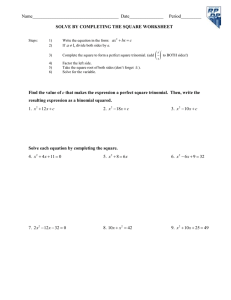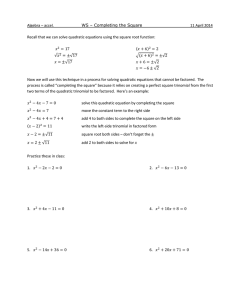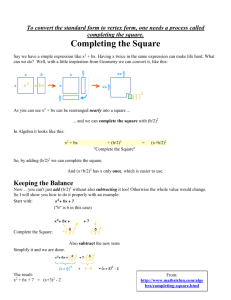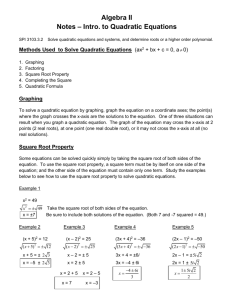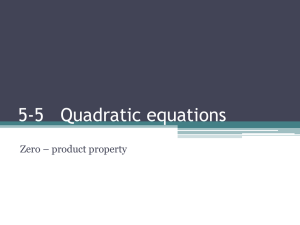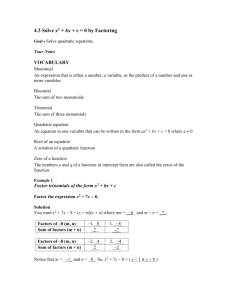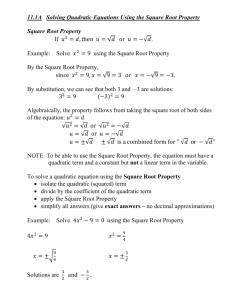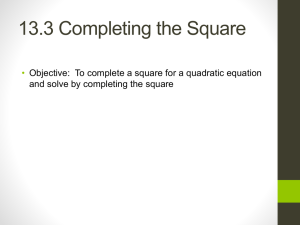Notes sect 6-4
advertisement
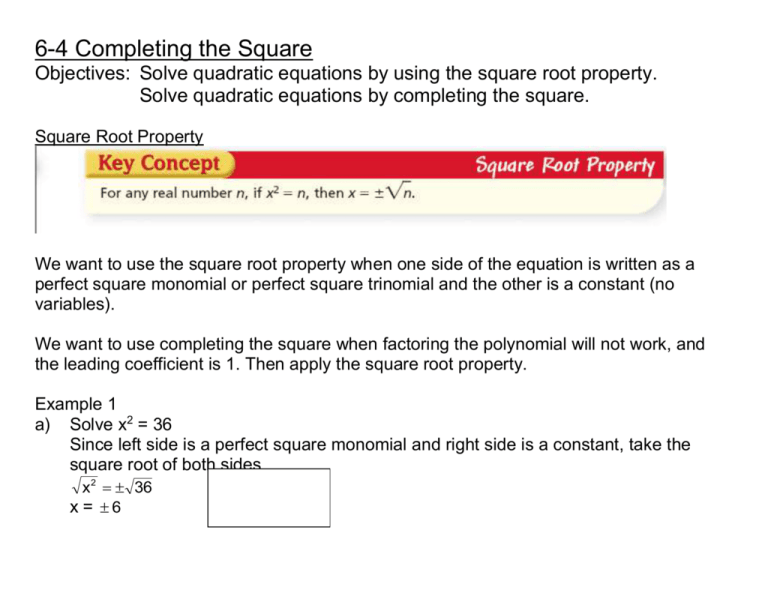
6-4 Completing the Square
Objectives: Solve quadratic equations by using the square root property.
Solve quadratic equations by completing the square.
Square Root Property
We want to use the square root property when one side of the equation is written as a
perfect square monomial or perfect square trinomial and the other is a constant (no
variables).
We want to use completing the square when factoring the polynomial will not work, and
the leading coefficient is 1. Then apply the square root property.
Example 1
a) Solve x2 = 36
Since left side is a perfect square monomial and right side is a constant, take the
square root of both sides.
x 2 36
x = 6
b)
Solve y2 = 20
y 2 = 20
y= 4 5
y = 2 5
y 4.47
Example 2
Solve x2 + 14x + 49 = 100
Notice that the left side of the equation is a perfect square trinomial (a trinomial that can
be written as the square of a binomial). Therefore, we can rewrite the left side as a perfect
square:
(x + 7)(x + 7) = 100
Factor left side as a product of 2 binomials.
2
(x + 7) = 100
Rewrite left side as a perfect square.
( x 7)2 = 100
Take square root on both sides, putting with constant.
x + 7 = 10
Apply square root
x + 7 = 10 or x + 7 = -10 Write 2 equations, letting binomial equal each value.
x = 3 or x = -17
Solve each equation.
{ -17, 3}
Write solution set.
Example 3
Solve x2 – 10x + 25 = 12
(x – 5)(x – 5) = 12
(x – 5)2 = 12
( x 5)2 = 12
x–5= 4 3
x – 5 = 2 3
x – 5 = 2 3 or x – 5 = 2
x = 5 + 2 3 or x = 5 - 2 3
x ≈ 8.46 or x ≈ 1.54
{1.54, 8.46}
Factor left side.
Rewrite left side as a binomial squared.
Take square root of both sides.
3
Completing the Square
Examples 2 & 3 required the left side of the equation to be a perfect square trinomial. If
that trinomial is not a perfect square, we can make it a perfect square by a process called
“completing the square”.
2
b
A quadratic trinomial expression in the form x2 + bx + c is a perfect square if c = .
2
To determine the necessary constant “c”, divide “b” by 2, and square the result.
b
The quadratic x2 + bx + c will then equal (x + )2
2
Example 4 Complete each square.
a) x2 + 12x + c
2
2
b 12
c = = = 62 = 36
2 2
x2 + 12x + 36 = (x + 6)2
b)
y2 – 18y + c
2
2
b
18
c= =
= (-9)2 = 81
2 2
y2 – 18y + 81 = (y – 9)2
c)
m2 + 7m + c
2
2
49
b 7
c = = = (3.5)2 = 12.25 or
4
2 2
m2 + 7m + 12.25 = (m + 3.5)2
Completing the square can be used in tandem with the square root property to solve
quadratic equations. It is most effective when a = 1 and the quadratic is either difficult to
factor or cannot be factored.
Example 5
Solve x2 + 8x – 65 = 0 by completing the square.
To use completing the square to solve an equation, move the constant term to the right
side:
x2 + 8x = 65
Rewrite the equation with a blank on each side.
x2 + 8x + ____ = 65 + ____
Determine the “c” value; then place this value in each blank.
2
2
b 8
c = = = (4)2 = 16
2 2
x2 + 8x + 16 = 65 + 16
Factor left side; simplify right side.
(x + 4)2 = 81
Apply square root property.
( x 4)2 81
x+4=±9
x+4=9
or x + 4 = -9
x=5
or x = -13
{-13, 5}
Example 6
Solve x2 – 4x + 11 = 0
x2 – 4x = -11
Move constant to right side.
x2 – 4x + ____ = -11 + ____
Add blanks
Find c value
2
2
b 4
c= =
= (-2)2 = 4
2 2
x2 – 4x + 4 = -11 + 4
Fill in blanks with c value
2
(x – 2) = -7
Factor left side; simplify right
( x 2)2 7
Apply square root property
x – 2 = i 7
x=2±i 7
{2 ± i 7 }
Text. P. 310, #15-19 odd, 25-29 odd, 32-37.
